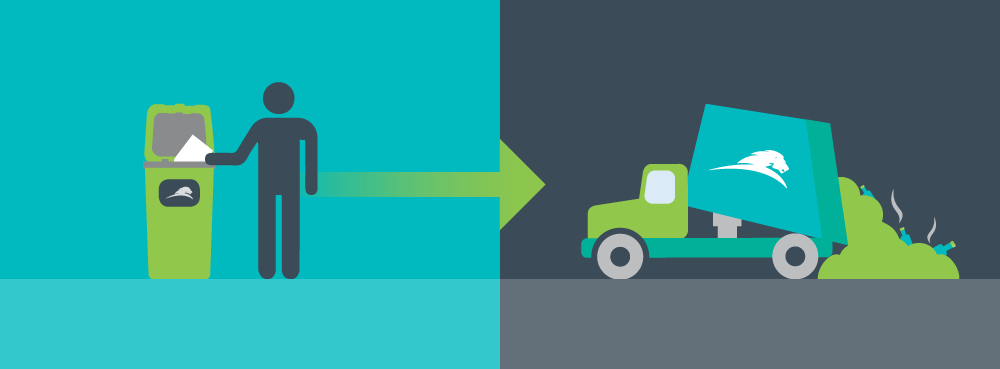The Importance of Cradle-to-Grave Medical Waste Management

Often termed ‘Cradle-to-Grave’, the full process of healthcare waste management extends far beyond the initial act of healthcare waste disposal. A cradle-to-grave life cycle process captures all the “moments” of your facility’s healthcare waste management journey including generation of waste, on-site storage, transportation from your site, scanning, treatment, and disposal. Each step in the process matters and you are responsible for each one.
Context and history of RCRA
The Resource Conservation and Recovery Act of 1976 was instituted to intervene in an alarming trend – that at the time only 10% of hazardous waste material was being managed relative to its risk profile. The magnitude of this equated to an estimated 51.3 million tons of hazardous waste in the United States being disposed of in an environmentally damaging manner. “RCRA”, as the Act has been commonly termed, established standards for storage, treatment and disposal facilities and mandated a “manifest system” for tracking waste from generation to final disposal. As the first federally instituted legislation around the process of handling and disposing of hazardous waste, RCRA was focused on the protection of the environment and human health.
How does this relate to you might you ask?
In the passing of the RCRA legislation, it was identified that no single individual or entity that handled hazardous waste was exempt from responsibility. Stringent guidelines were enforced for not only the waste handler (a waste company licensed to transport, store and treatment medical waste and other healthcare generated hazardous wastes), but also for the waste generator themselves. Cradle-to-grave regulations state that the medical waste generator, whether a hospital, surgical center, physician’s office or long-term care facility, is responsible for its waste from the point of generation right through to final disposal. There is no time limit or date of expiration that will release a waste generator from this long-term management responsibility, and even hiring an accredited medical waste company to transport and dispose of waste doesn’t absolve them from cradle to grave responsibility.
A few tips in choosing a medical waste partner
This is an important decision because as a waste generator once your medical waste or hazardous waste leaves the confines of your building or back dock, it is completely in the hands of another company, and yet you are still responsible! Of course, we would love you to say, “no competition here, I’m choosing Daniels” but we realize that we’re not the perfect fit for everyone, and you deserve a options, so here’s a few considerations:
- Common Sense – it’s the great equalizer. If the waste contract costs are significant less than other competition, there may be a reason for this. Do some research and be 100% confident in your decision before diving in.
- Compliance Checks – As a consumer, you are able to view public violations and other citations – do some research and make sure you’re not taking an uncalculated risk
- Packaging – Containers must not be rusted or leaking and must be fully sealed to prevent release of waste contents and/or potential for contamination.
- Labelling and Securement of Waste – two important aspects not only of collection, but transportation of waste. Make sure that your provider has licensed transport and permits, as well as adequate containment means for ensuring the protection and securement of the waste until its final destination of disposal.
- Manifests – this is, quite simply, your insurance policy! It ensures that you can provide clear proof that your waste has been treated and disposed of in an environmentally responsible manner. By law if you do not receive a manifest within 45 days, you are responsible for reporting this infringement to the EPA.
At Daniels, this is how we view our responsibility…
We’re an extension of your facility. As a business we have coined the term “within the four walls” to reflect the unique differentiation of how we operate. We are committed to driving clinical and environmental change from within by ensuring that even before waste is collected at the loading dock or in a medical waste holding room, that the following steps are taken:
- We first learn about your facility and your unique healthcare waste management needs before offering a solution—we want to get it right! Every healthcare facility we work with, whether a nursing home, surgery center or oncology facility, has unique staff processes, waste volume and compliance needs. We start here by listening to you.
- Education is key. The correct medical waste containers in the correct locations has a huge impact on segregation efficiency, staff safety and total costs! Through a thorough understanding of the healthcare waste streams you are managing, we help you to divert “general waste” from medical waste streams and significantly lower your costs.
- You may have specialist healthcare waste streams that require special handling. We can help navigate this by offering a comprehensive formulary analysis tool that helps you easily separate pharmaceuticals that may be hazardous from non-hazardous. We ensure your staff and facility are protected in its cradle-to-grave responsibility.
- Safe medical waste containers and sharps waste containers are our speciality! Our sharps containers, chemotherapy containers and pharmaceutical container systems have been clinically reviewed with empirical testing. Not only that, but all our reusable medical waste containers have even been filled with water, frozen, and dropped on concrete from 3 angles just to prove that they are unbreakable! We don’t take our responsibility lightly. Our clinically-designed healthcare waste containers are hands-free, leakproof, tamperproof and securely lockable to prevent medication theft.
- Transportation – we go the extra mile. Our clinically-designed containers are the only UN Certified sharps and medical waste containers in the United States which do not require any secondary packaging. But even though this is the case… we still transport our containers in a secure transportation unit that eliminates contamination and adds further protection to containers in transit.
- Electronic manifest system – we ensure that all waste destruction records are available within 24 hours of the waste being treated on our online manifest portal with printable documentation retrievable at any time.
- Security – All Daniels sites are monitored by security cameras, and all Daniels trucks are GPS routed to ensure 100% traceability and visibility of the medical and pharmaceutical waste being transported and destroyed.
Many companies manage healthcare waste “on the side” as an extension of their broader waste offering. We solely focus on healthcare waste. At Daniels we set out with a singular vision of making healthcare safer, and over 30 years later we are still passionately pursuing this vision. What we do inside the four walls of healthcare is not merely to manage cradle-to-grave waste compliance responsibility, but to partner with our customers in driving safety, environmental and clinical outcomes through their medical waste management, an accomplishment we have proudly succeeded in for over 18 years in the United States.
Since the Resource Conservation and Recovery Act was enacted in 1976, we have come a long way in responsible healthcare waste management, but we’re not there yet. Every healthcare facility and every medical waste transporter has a custodian responsibility to optimize collection, storage, treatment and transport, and now more than ever the spotlight is on to not only manage regulated medical waste compliantly but ensure that we’re actively diverting non-regulated waste streams into general waste. Within the cradle-to-grave process, disposal represents the “grave.” The whole process begins after all recycling and re-use avenues have been utilized, and is ultimately the end result after treatment of whether a waste stream is deposited into landfill or destroyed by methods of incineration.
Where to from here…
As a medical waste disposal partner, our goal is to help our customers minimize waste volumes, segregate better, protect their staff, and ultimately reduce their overall costs. Every single one of these objectives requires a 100% buy-in from us as a medical waste services partner, but it also requires 100% dedication from our customers. Cradle-to-grave responsibility is not a singular commitment. With traceable reporting capabilities, compliant transport and processing, and expert clinically-trained staff, we know we can offer the highest safety standards in the industry when it comes to cradle-to-grave medical waste processing. If you would like some guidance in how to ensure your facility is meeting its cradle to grave medical waste requirements, speak to us today.
Proactive sharps injury reduction strategies are required by law. As reinforced through the OHSA Needlestick Injury and Prevention Act, it is also a legal requirement that healthcare facilities annually seek and evaluate safer technologies that could assist in reducing staff exposures. To assist your facility in bringing renewed staff awareness around the topic of sharps injuries and preventable strategies, download our sharps injury prevention poster.
Let's Talk!
Your time is valuable, and we don’t want to play hard to get. You can either phone us directly on the details listed on our contact page, or feel free to fill out this short form and one of our team members will get back to you as quickly as possible.
